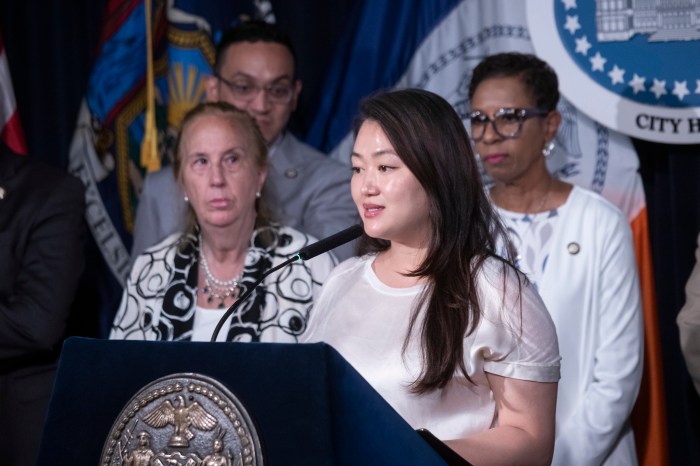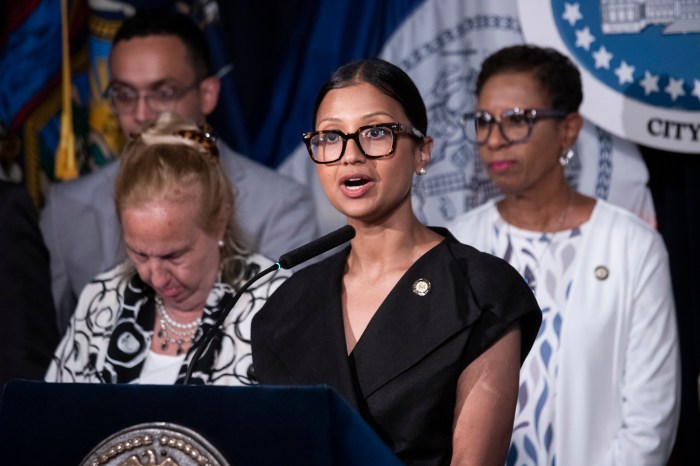Kilmar Ábrego García says he was tortured in El Salvadorian prison. Hundreds...
Jul. 3rd, 2025 01:45 amNow-Shuttered Migrant ‘Welcome Center’ Was Her Growing Family’s Home
Jul. 3rd, 2025 01:39 am
The Roosevelt Hotel, which became the first stop for 155,000 migrants as it was remade into the city’s welcome center for an influx that Mayor Eric Adams once said “will destroy New York City,” closed its doors to them last week. But people continue to arrive.
“One guy came today and was asking me to help him find a shelter, and I had to explain to him that I don’t work with the city,” said an employee of the hotel’s owners, Pakistan International Airlines, who has worked at the Roosevelt for over 20 years.
“He didn’t really get it, so he kept persisting with me trying to find him a shelter and unfortunately I just don’t know any shelters.”

The employee, who declined to share his name for fear of backlash from his employers, said the migrant, a man from Francophone Africa who appeared to be in his 60s and spoke little English, had followed instructions from Google and gone to another site — the former St. Brigid school in the East Village — earlier in the day. But St. Brigid, which served as a “reticketing center” for thousands of migrants and asylum seekers, also closed last week.
“He looked more terrified, more scared because I’m figuring – first time in a new country, first time in a new city and all that, and don’t know where you’re gonna sleep tonight,” said the hotel employee. “And I just couldn’t help him, which made me feel bad.”
The worker leaned on a fence outside the hotel just after Adams and other city officials held a press conference in the building’s ornate, marble-floored foyer to mark its closure and claim credit for an “historic accomplishment” after 237,000 migrants passed through the city’s ad-hoc new shelter system for them over the last three years, including one period where the city said it was out of space and people slept on the streets outside the building.
Adams, flanked by current and past city officials including Immigrant Affairs Commissioner Manuel Castro and former Deputy Mayor Anne Williams-Isom — who resigned in February following Adams’ alignment with the Trump administration’s immigration strategy — praised “the amazing team.”

“What they were able to accomplish in a short period of time, history is going to be kind to them and how they provided service in a humane way, in spite of all the politics,” Adams said. “The present day may not be kind, but history will be kind.”
He called the closure the end of a story, and complained about how “over and over again, we were criticized. There was so much reports that we were inhumane to immigrants.”
“As we take this final step, we can look back and say, ‘Job well done,’” Adams concluded. His administration, he said, had “showed the world what humanely managing a national humanitarian response looks like.”
‘We Arrived Lost’
One person who experienced much of the city’s migrant response firsthand had a different perspective — appreciative of the help her family had received but painfully aware of its limits.
Days before the mayor proclaimed a “job well done,” Dina, 32, sat on a stoop outside the newly empty Roosevelt with her baby daughter on a sweltering afternoon as they waited for the bus to drop off her son from elementary school.
As raids by sometimes-masked federal officers have accelerated inside courtrooms and around the city, Dina faced a new set of fears. “We barely go outside any more,” Dina said in Spanish. She asked to be identified by that name to avoid endangering her immigration case. “I leave to pick up the boy, and that’s it.”
She, her husband, and her then-eight-year-old son had sold everything they owned in Maracaibo, Venezuela and spent their life savings to reach the United States. They spent two days in Texas after crossing the Rio Grande in December 2023, before a local organization offered them tickets out of the state.
“My husband and I asked ourselves, ‘What are we going to do in New York? We don’t know anyone there,” said Dina. “And he said, ‘Well, we don’t know anyone, anywhere.’ So we chose New York.”
After 40 hours of travel — a plane to Atlanta, a bus to New Jersey, a train to Penn Station — they arrived in Manhattan in the middle of a frigid night, without winter clothes or cell phones. Dina was a few months pregnant. They were directed to a bus that brought them to the Roosevelt.
“When we got here, we arrived lost,” Dina said. “I didn’t even know where we were. They brought us here to the shelter, and they gave us a hand.”

Dina, her husband, and her son huddled in the lobby for hours before they were given a shelter placement in Queens. They set out into the cold. “We didn’t have any clothes beyond what we were wearing,” said Dina. “My son began to cry from the cold.”
Another asylum seeker offered her pink winter coat to Dina’s son. He was too cold, Dina recalled, to object to the color. Hours later they were sent out to find their way, without a working cell phone, to a shelter in Queens.
The family stayed for 30 days in the Queens shelter, then returned with all of their possessions to the Roosevelt for another wait to be assigned a room in Brooklyn.
Dina’s son didn’t go to school while they were in Brooklyn. “I fell into a depression there because my son couldn’t study,” she said. “I was very lost.”
A month later, they returned to the Roosevelt for another placement. Dina was visibly pregnant and they were assigned a room there. A social worker — the first one she mentioned encountering in the shelter system — helped Dina and her husband apply for work permits.
At the Roosevelt, the family of three shared a single room and one bed. They didn’t have access to a kitchen, and the family missed having home-cooked Venezuelan food, Dina said. Her son lost weight.
“They never told us what was happening,” she said, “but we put up with it because they gave us stability, more than anything.”

Later the same month, in March New York City reached a legal settlement with Coalition for the Homeless and The Legal Aid Society regarding the “right to shelter” requirements the Adams administration had been trying to roll back for the city’s newest arrivals.
Migrants would now be guaranteed a room for no more than 60 days. When their time ran out, families would have to pack up their belongings and return to the Roosevelt to request a new stay.
Dina and her family gradually settled into the hotel. Parents, she said, would look out for each other. “Everyone helped each other,” she said. “If there was a mother who was working, the others would offer to help” with their children.
Dina had some limited prenatal support from the hotel, she said, but there was “no support” for her eight-year-old son, who was adjusting to a new country and language. “There was never anyone looking out for him, not one person caring for him, not even a social worker.”
By the time their 60 days were up, Dina was eight months pregnant. The family was granted an extension at the Roosevelt.
Dina gave birth a month early, through an emergency cesarean section.
The family was still at the Roosevelt this March, when later reporting revealed that Deputy Mayor for Public Safety and longtime Adams ally Kaz Daughtry worked with Trump “border czar” Tom Homan to plan large-scale immigration raids at the Roosevelt and another Manhattan shelter. Those plans were scrapped after Police Commissioner Jessica Tisch blocked the effort, the New York Times reported.
In May, just as her baby was turning one, Dina and her family were told the Roosevelt was closing and they would need to seek a new placement. They were assigned to a shelter 20 blocks south.
The family packed up their belongings and moved again, to their fourth assignment in 18 months. In a few weeks, with minimal information from shelter management, they’ll have to apply for another new placement.
‘The Same Scared Look’
School dropoffs are done for the summer, and the Roosevelt’s welcome center is no more. Pakistan International Airlines is reportedly looking to sell the property as their three-year, $220-million contract with the city winds down.
Still, at least ten people arrive at the hotel every day seeking shelter, the 20-year hotel employee said. That comes as the Adams administration reports that fewer than 100 migrants are now arriving in the city.
Some come with babies and small children. “They look lost,” the employee said. “They all got the same scared look.”
They walk up to the shuttered doors of the hotel, read the notices pasted to the glass — in Spanish, Fulani, Bengali, Ukrainian, and other languages — informing them of the permanent closure of the arrival center and redirecting them to other intake centers around the city. Then, they continue on their way.
Our nonprofit newsroom relies on donations from readers to sustain our local reporting and keep it free for all New Yorkers. Donate to THE CITY today.
The post Now-Shuttered Migrant ‘Welcome Center’ Was Her Growing Family’s Home appeared first on THE CITY - NYC News.
een glish: the google translate voice as a vocaloid, and it’s good
Jul. 2nd, 2025 12:00 ammeet me in the sheets / we can CSV
Oh, is that not independently convincing to you? Okay, well, what about the Sims:
No? Well, you’re here, so…
Everyone prefers the web they rеmember (of course)
It was hеre before me and it’ll be here after
The book of eternal September (wow)
I’m just glad that I have a chapter
Planned obsolescence, enshittification (eek!)
Sounds like a hostage situation (ha, o-o-o)
[…]
I grew up on family computers
And online arcade SWFs
I am admittedly weak for little audio details you can hear in giant noise-canceling headphones. I am also always in search of music to propel me further through the day, always energetic, never contemplative. It delivers!
Wanna Sit Down? You Gotta Solve The Rubik’s Cube Chair.
Jul. 2nd, 2025 11:56 pm


If you want to sit in this chair, you have to be able to solve a Rubik’s Cube because the chair is a Rubik’s Cube. (Ok, technically it looks like you only need to place the four leg corners of the chair correctly, but we’re not going to pick nits on this because it is fun and loooorrrrrrrd do we all need some fun right now.)
Oh and I like how the unsolved chair in the last photo looks like it’s striking a break dancing pose. Fresh! (via moss & fog)
Tags: design · furniture · games · Rubik’s Cube
American science to soon face its largest brain drain in history. “Over...
Jul. 2nd, 2025 09:32 pmCouncil Members Won, Hanif pass bills to protect immigrants from fake lawyers
Jul. 2nd, 2025 08:46 pmJul. 2, 2025 By sobrien
July 2, 2025 By Shane O’Brien
The New York City Council has passed legislation introduced by Queens Council Member Julie Won and Brooklyn Council Member Shahana Hanif, aiming to combat immigration legal services fraud, whereby predatory actors exploit the fears of immigrant communities by offering false promises of legal services.
Legislators said the practice, known as “notarial fraud,” can result in victims paying thousands of dollars for legal services that often leave them worse off.
Advocates said the “long-standing issue” has worsened considerably with the influx of new arrivals in New York City.
Intro 980A, introduced by Won, doubles penalties for “egregious violations” of the city’s rules governing immigration assistance services. Egregious violations for prohibited conduct can include the unauthorized practice of law or threatening to report a customer to Immigration and Customs Enforcement (ICE).
Won said she introduced the legislation after numerous constituents contacted her office to inform her that they had been victims of predatory immigration services and scammed out of thousands of dollars.
The law also increases fines for immigration assistance service providers that do not comply with applicable requirements, such as the requirement to execute a written contract with customers, the requirement to include specific language in signage and advertisements and the requirement to retain documents.
Under the new law, the civil penalty for offenses would be at least $5,000 and no more than $10,000 for a first violation, rising from $3,750 and $7,500, respectively. For each succeeding violation, the penalty would be a minimum of $10,000 and a maximum of $15,000.
For any violations related to guaranteeing particular governmental actions on advertisements, the civil penalties would be between $7,500 and $10,000 for a first-time violation and between $18,000 and $20,000 for any subsequent violation.
According to the law, any immigration assistance service providers who advertise services must post or include with the advertisement a legally required notice of the services they are not authorized to provide.
Won said the law would help combat a rise in fake lawyers and predatory providers.
“It is deplorable to overcharge and mislead desperate community members searching for a legal pathway to citizenship,” Won said in a statement. “With the passage of Int. 980-A, fake lawyers and predatory providers will now receive double the civil penalties for serious violations of NYC’s laws for Immigration Assistance Services.”
Hanif, meanwhile, introduced Intro 205A, which will require the Department of Consumer and Worker Protection (DCWP), the Mayor’s Office of Immigrant Affairs, the Mayor’s Office of Ethnic and Community Media, and other appropriate agencies to work collaboratively to educate immigrant communities about common immigration-related scams.
The education and outreach campaign will be conducted in all designated city-wide languages and temporary languages.
The campaign will also include guidance on how to identify and avoid common fraudulent schemes, information on credible immigration legal service providers, and how to report fraud using DCWP’s complaint mechanisms.
Hanif stated that federal immigration policies have created fear and anxiety among New York’s immigrant communities, adding that bad actors often seek to exploit that anxiety. She said data from the DCWP highlights that the problem has increased significantly in recent years.
“The Trump administration’s anti-immigrant policies have generated anxiety and confusion among immigrant communities. Bad actors often exploit these vulnerabilities through fraudulent practices, charging high fees and sometimes even sabotaging ongoing immigration cases,” Hanif stated.
Both Won and Hanif stated that the measures target the most significant laws passed in the US to target “notario fraud.”
“Today NYC is passing the most comprehensive and aggressive laws in the nation to protect immigrants from ‘notario fraud,'” Won said in a statement Monday.
Council Member Shekar Krishnan, who co-sponsored both pieces of legislation, said the laws would have a huge impact on communities in the diverse immigrant neighborhoods of his district, including Jackson Heights, Elmhurst and Woodside.
“This legislation will protect them from scammers, allow them to navigate the legal system more easily, and ensure they get quality legal assistance,” Krishnan said in a statement.
Council Member Sandra Ung, who also supported the legislation, said the laws would help protect immigrant communities against people who view heightened anxiety as an opportunity to exploit vulnerable members of the community.
“They offer so-called immigration ‘services’ that are deceptive at best and outright fraudulent at worst, charging people thousands of dollars for promises they can’t keep and paperwork that won’t help,” Ung said. “Regardless of immigration status, all New Yorkers deserve access to legal services that are trustworthy, transparent, and grounded in a real understanding of the law.”
A number of immigration services also praised the Council for passing both pieces of legislation, including Catholic Migration Services, which provides a wide range of services to immigrants of all faiths.
Magdalena Barbosa, the organization’s senior vice president and director of legal services, applauded the Council for passing the legislation.
“The New York City Council understands that now, at a time of unprecedented fear and anxiety in immigrant communities, is the time to act to ensure immigrants understand the dangers of working with notarios and the importance of higher penalties to deter bad actors,” Barbosa said.
The post Council Members Won, Hanif pass bills to protect immigrants from fake lawyers appeared first on Jackson Heights Post.
Architect David Romero has built several digital models of Frank Lloyd Wright’s...
Jul. 2nd, 2025 08:26 pmOpinion: The Urgency Of Preserving Low- And Moderate-Income Rent Stabilized Housing
Jul. 2nd, 2025 08:13 pm“The combination of tightening rents and diminished safety net programs has precipitated a slow but accelerating deterioration of this ‘naturally occurring’ affordable housing.”


There are slightly less than 1 million rent stabilized apartments in New York City, of which 780,000 were built before 1974. Most of this older housing is concentrated in the city’s low and moderate-income communities. As reported in the latest (2023) Housing Vacancy Survey (HVS), the city-wide household median income of these pre-1974 apartments is about $60,000 a year. In the Bronx, it’s about $42,500 a year for about 200,000 apartments, predominantly privately owned.
This older housing is arguably the largest source of affordable housing in the city. Two self-inflicted wounds have affected these properties.
First, in efforts to curb vacancy decontrol in higher income areas, the 2019 Housing Stability and Tenant Protection Act (HSTPA) put a tourniquet on the cash flows of lower-income buildings—eliminating rent increases on vacancies and sharply narrowing permitted increases to pay for both individual and building-wide capital improvements.
This has made it difficult not only to operate the building amidst rising expenses, e.g., insurance, taxes and utilities, but also to pay for ongoing repairs in these aging buildings. Recent testimony by the Furman Center to the Rent Guidelines Board documented this problem. Furthermore, the rise in interest rates means that as mortgage loans come due, refinancing rates, assuming there are banks offering refinancing, would increase from 3-4 percent to over 6 percent.
Second, safety net programs designed to help off-set increasing operating and repair costs have frayed. The program known as J-51, which would reduce real estate taxes to help pay for critical repairs, has had its benefits whittled down over the years to the point where they’re insufficient to incentivize meaningful renovations. A second program of low-cost secondary loans (1 percent), often coupled with J-51 for the most distressed buildings, is both underfunded, with processing too complicated and time consuming to be used at a scale that’s needed.
The combination of tightening rents and diminished safety net programs has precipitated a slow, but accelerating deterioration of this “naturally occurring” affordable housing.
The collapse of Signature Bank was in part caused by defaults on its loans to rent stabilized buildings. The Community Preservation Corporation, partnering with Related Fund Management, has been selected by the FDIC to fix approximately 35,000 units in buildings that had about $5.6 billion of Signature mortgages. Their task is to restructure the properties so they remain affordable by restoring their physical and financial health. In addition to likely obtaining real estate tax abatement from the city, the FDIC will put up the lion’s share of $550 million to help pay for repair and other costs in these buildings.
Signature Bank loan problems are the tip of the iceberg. A survey done by Maverick Real Estate Partners estimates there’s about $50 billion of bank loans secured by properties that have 75 percent or more of rent stabilized apartments. Many of these are located in low and moderate-income neighborhoods.
Many of these loans are no doubt classified as troubled by the banks and their regulators. Herein lies an opportunity to restore potentially a large number of affordable buildings to physical and financial health.
First, reinvigorate safety net programs in designated low and moderate-income areas: Reinstate as-of-right J-51 real estate tax abatements with updated eligible costs, enhanced to support more extensive building-wide improvements. (Past benefits could be expanded by 150 percent for defined moderate renovation.) This can be coupled with low interest city and state loans, and possibly funds from the Federal Home Loan Bank’s affordable housing program.
Further investment can be made by existing or new owners. Needed work would include repairs and/or replacement of major building systems, e.g., plumbing, wiring, heating, etc., so that their useful life is extended by at least 30 percent longer than the term of the loan as certified by an approved engineer/architect. Further cash flow would be generated by permitted major capital rent increases, waived in all or in part for eligible seniors as per the Senior Citizen Rent Increase Exemption program.
In turn, the bank would restructure its debt to a fixed payment, say for 10 or 15 years, adjusted through discounts to produce a positive cash flow both to provide a return to owners, and a cushion to make ongoing repairs, e.g., a ratio of net income to debt payments of 115-120 percent. This combination has a long track record of success in preserving distressed affordable housing.
Second, to incentivize the banks to undertake such steps, the State Mortgage insurance Fund (MIF), could provide “first loss” insurance to enhance the security of these restructured mortgages. The mortgage insurance would last only as long as the mortgage term. It would not cover the risk of refinancing. All other requirements for mortgage insurance would have to be met, including the above work scope; the loan size consistent with MIF’s loan to value standards; approved repair work equal at minimum to 20 percent of the loan.
How big might this program be? The MIF’s capital reserves, which set aside one dollar for every five dollars insured, is funded by a .25 percent surcharge on the state’s mortgage recording tax, insurance premiums (.5 percent annual fee on the outstanding balances of multifamily loans), and interest on its capital reserves.
Over the years, MIF has had substantial untapped capacity as it has returned unused surcharge funds to the state. Going forward the MIF might expand its program to provide the “top loss” insurance, for say 25 percent, for the restructured loans. The City’s Residential Mortgage Insurance program could supplement this effort, potentially creating billions of dollars of additional insurance capacity. This fully aligns with both mortgage insurer’s mission to “encourage investment in underserved areas.”
Will the banks view the cost and time of such restructuring worth moving troubled loans to performing status? It is uncertain. A more likely response for some banks may be to sell these loans at the best price they can get, or go through a lengthy foreclosure—both routes leaving the health of the building to an uncertain fate. Others might see an opportunity to buy discounted debt and work with owners experienced with the public programs to restore the properties to financial and physical health.
Will the government expand the use of public insurance, and safety net programs to preserve this housing? This must be measured against the cost of inaction, or ineffective action. If public action is taken, it must be credible, best demonstrated by the creation of a simplified processing regimen to encourage broad private participation.
Why is the use of mortgage insurance important? The precipitous changes in HSTPA, undermined widely held assumptions regarding the long-term stability of rental projects. As a result, some banks have stated their intention to cut back on new loan originations for rent regulated housing.
Fixing these properties at any scale must engage the banks who hold these mortgages. A credible program to fix these properties, bolstered by mortgage insurance, may create renewed confidence in the soundness of this housing. Such assurance may be necessary to re-engage skeptical lenders to fund current and future rental projects.
If properly targeted, this program could have significant results in arresting decay, improving tenant living conditions while preserving housing affordability. It would be beneficial not only to residents, but to owners, banks and investors. It highlights the need to fix the problems of the HSTPA, and to reinvigorate safety net programs—two important corrective actions to keep this housing sound and affordable.
Michael Lappin is the former CEO of the Community Preservation Corporation (1980-2011). During his tenure, CPC financed and/or developed the preservation and building of over 92,000 affordable apartments in New York City. Currently he heads Lappin Associates, providing development and advisory services for affordable housing.
The post Opinion: The Urgency Of Preserving Low- And Moderate-Income Rent Stabilized Housing appeared first on City Limits.

In a record-breaking season for outside spending in a New York City election, the City Council saw the sharpest surge, driven by special interest groups and corporations pushing back on efforts to expand business regulations.
While total independent spending across all primary contests rose by 12.5% from 2021, spending in Council races more than doubled, jumping from $6.6 million to $14.3 million this year. Voters likely witnessed this deluge in the profusion of ads targeting contested Council races that jammed mailboxes and airwaves alike.
Under New York State law, independent expenditure groups can spend money on advertisements supporting or opposing candidates’ campaigns, but cannot coordinate with the campaigns themselves.
Just under half of the total spending on these local races was put forth in support of incumbent candidates. In the 31 contested races, 20 incumbents prevailed.
Airbnb was the single biggest spender on Council primaries, shelling out $2 million in support of 12 candidates through its group Affordable New York, which also spent just over $1.3 million opposing mayoral candidates Assemblymember Zohran Mamdani, city Comptroller Brad Lander and former city Comptroller Scott Stringer. In 2022, the Council passed a law that heavily restricts short-term rentals, but a bill is pending that would permit some homeowners to list their property on Airbnb.
Uber came in second in total spending, shelling out $2.4 million across another 12 Council races. The Council is currently considering a bill that would make it harder to kick drivers off the platform.
Common Cause Executive Director Susan Lerner said the swell of outside spenders in this year’s Council election was unprecedented.
“We saw this kind of spending in the last two elections, but we are seeing it in an outsized way in 2025. When moneyed interests feel that they are not able to control the system, they are going to pour more money into other elections to sway,” says Lerner.
Here’s a breakdown of where some of that money went, and how candidates backed by this wave of outside money fared.
Brooklyn
Bed-Stuy’s District 41 incumbent, Councilmember Darlene Mealy, was the beneficiary of $1,013,855 in independent advertising expenditures, the second-highest amount spent on behalf of any City Council candidate. Mealy — who faced eight opponents in the primary, none of whom received any outside spending — secured her seat with 65% of the final round votes.
Mealy’s top donors were ride-share company Uber, who contributed $334,684 via their Uber NY PAC, and New Yorkers for a Better Future 2025, which gave $257,215. The latter group’s top donor was billionaire hedge-fund manager Bill Ackman.
District 39 runner-up Maya Kornberg, senior research fellow at the Brennan Center for Justice, received a $395,545 boost from outside money in her bid to unseat incumbent Shahana Hanif. The lion’s share of this funding came from Uber NY PAC, which spent over $250,000 on 14 separate ads supporting Kornberg.
As THE CITY previously reported, Hanif is the lead sponsor on a bill to extend paid sick leave to delivery workers and co-sponsored a bill prohibiting driver account deactivations.
Despite receiving just over $81,000 spent on her behalf, mostly from pro-development group Abundant New York, Hanif clinched the race with 70% of the district’s vote.
Queens
Outside spending flowed heavily to Queens’ District 28, where five challengers faced off to replace Council Speaker Adrienne Adams’ soon-to-be vacant seat. Tyrell Hankerson, Adams’ Chief of Staff, drew nearly $1 million in ad spending from nine independent expenditure groups, more than any other City Council candidate. Hankerson won with 59% of the vote.
Hankerson received backing from 9 independent groups, including Airbnb’s Affordable New York and DoorDash-supported Local Economies Forward NY. As THE CITY reported last month, DoorDash was also the initial donor to a group supporting Adrienne Adams’ mayoral campaign.
In her bid to fill the empty District 21 seat, longtime community developer Shanel Thomas-Henry was helped by $395,055 from three independent groups, including two backed by pro-charter school interests and the Real Estate Board of New York.
One of her challengers, Queens Democratic Party District Leader Yanna Henriquez, benefited from $881,248 from six groups. Uber accounted for nearly half of the total spending on Henriquez. Despite the flood of funding to support her candidacy, Henriquez was eliminated after the third round of ranked choice voting, and Thomas-Henry won the seat with 53% of the vote.
The Bronx/Manhattan
Independent expenditure groups poured more than $1.6 million into the Upper Manhattan/ South Bronx District 8 race to replace term-limited Councilmember Diana Ayala. About half of that money supported Ayala’s Chief of Staff, Elsie Encarnacion, who garnered a combined $820,680 in support from eight outside spending groups.
Chief among them was Airbnb-backed group Affordable New York, helping Encarnacion win 58% of final round votes to replace her boss.
Up until late May, Ending Homelessness & Building A Better NYC was the only independent expenditure group involved in the District 8 race, supporting candidate Wil López with $365,164 in early spending. Operated by Tomás Ramos, who managed social services nonprofit group Oyate, the local super PAC involved in seven City Council races was entirely funded by Wall Street financier Michael Jenkins.
Finishing second with 42% of the vote, López also received a $126,675 boost from New Yorkers For A Better Future, funded by lobbying firm Capitol Consulting.
Affordable New York, DoorDash-funded Local Economies Forward and United Federation of Teachers-supported United for NYC’s Future entered the fray later in the race, supporting Encarnacion.
Third-place candidate Clarisa Alayeto, a former administrator at Dream Charter School, received $327,809 in aid from pro-charter school groups New Yorkers for A Balanced Albany and Moving New York Families Forward.
In Lower Manhattan, outside spending committees representing the real estate industry and the landlord lobby spent $385,149 to oust Councilmember Chris Marte and support his challenger, lawyer Jess Coleman. Two groups supporting Marte, Ending Homelessness & Building A Better NYC and Downtown Independent Democrats, spent just over $25,000.
Marte won the race with 62% of the vote, with Elizabeth Lewinsohn, a former NYPD counterterrorism policy chief, coming in second and Coleman in a distant third. The election took place just a day after City Hall brokered a deal with Marte to save Elizabeth Street Garden by cancelling an affordable housing project for seniors that would be built on the site — and instead rezoning three lots to build future housing.
In District 12, nine groups including Affordable New York and New Yorkers for a Balanced Albany spent just under a million dollars to re-elect incumbent Councilmember Kevin Riley.
He faced little competition in the Northeastern Bronx district, which includes the key voting bloc of Co-op City. His challenger, ex-Councilmember Andy King, was removed from the same seat in 2023 after a series of ethics violations. Riley secured his seat with over 75% of the vote.
Our nonprofit newsroom relies on donations from readers to sustain our local reporting and keep it free for all New Yorkers. Donate to THE CITY today.
The post PAC Spending in Council Races More Than Doubled, Fueled by Money from DoorDash, Airbnb and Uber appeared first on THE CITY - NYC News.
Astoria Cook Club brings neighbors together through monthly potluck meetups
Jul. 2nd, 2025 08:20 pmJul. 2, 2025 By jmilitello

Astoria Cook Club hosts monthly meetups at Our House. Photo credit: Astoria Cook Club.
July 2, 2025 By Jessica Militello
Something’s definitely cooking in Astoria, thanks to the monthly potluck meet-ups hosted by Sweet Tones founders Toni Critelli and Mike Mroz, known as the Astoria Cook Club.
The potluck meetups, which have been taking place at Our House Astoria, located at 23-71 31st St. since the start of the year, offer a fun, low-pressure way for locals to try recipes from around the world and share their creations with neighbors. The alcohol-free gatherings encourage community-building through food and conversation in a creative, relaxed environment.
“I feel like our community is so strong to bring this here and cater it specifically to Astoria and bring people together in an environment that didn’t necessarily involve bars,” said Critelli. “I think we do have a big community who are looking for more of a wellness lifestyle, connecting with people in a very relaxed environment, and that’s kind of where it first started. My partner and I were trying to find people in the area where we can connect with people over food, who genuinely enjoy trying new recipes and trying new things.”
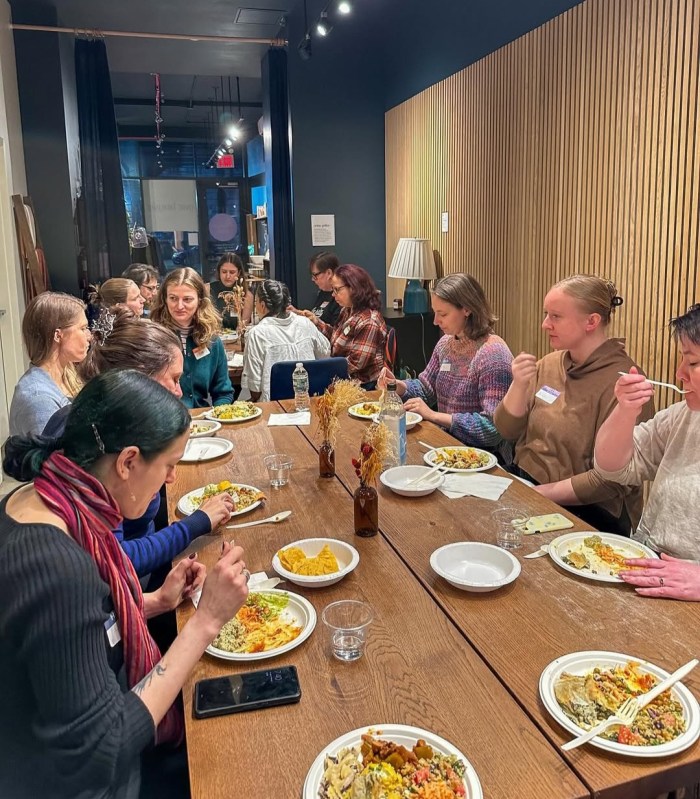
The potluck meetup is a great way to connect and create. Photo credit: Astoria Cook Club.
Critelli and Mroz, who live in Western Queens, first built local connections after launching Sweet Tones Desserts in late 2023. Their gluten- and dairy-free treats—like strawberry jam pop tarts and rosemary focaccia muffins—are sold online, at pop-ups, and through community markets and shops like the Astoria Farmers Market, The Honey House, and InCasa.
After bonding with the community through their desserts, the idea for a cooking club grew naturally. A friendship with Earth and Me founder Kayli Kunkel led to an opportunity to host the events at Our House, a cozy coworking space co-owned by Kunkel. Each event is themed around a specific cookbook or cuisine, with participants choosing a dish to prepare ahead of time and bringing it to share.
Whether you’re a kitchen novice or an experienced cook, the meetups offer a welcoming space to explore new dishes and make new connections.
“Something we’ve been trying to do is choose themes that have ingredients that are very accessible to Astoria,” said Critelli. “For example, on June 27, we did a Mediterranean summer theme, and I feel like, what’s great about Astoria is we have so many great Euro markets, so I think that’s something people are really excited about.”

Dishes from a past cook club meet-up. Photo credit: Astoria Cook Club.
The club typically hosts 15 to 20 guests per event. Attendance costs $10, which goes directly toward renting the space. Subscribers to the club’s email list receive early access to sign-up info a day before the event is announced on Instagram. Space often fills quickly.
The warm, flexible setup at Our House has made it an ideal venue.
“[At Our House] it’s really beautiful and it’s just a really cute space,” said Critelli. “They just updated the patio and there’s more seating in the back, so there are a lot of possibilities. It’s also nice because the owners let you curate the space in a way that works for your event, so it’s great to have that control and shape the space around whatever environment makes the most sense for how many people we get.”
Participants are encouraged to stay within each event’s theme but are welcome to adapt recipes or bring dishes they feel comfortable making.
“If guests like, they can choose a recipe from the meet-up’s particular theme, but follow a recipe they already know or one that they like better,” Critelli said. “This gives participants the ability to express themselves the way they’d like and cook according to their own comfort level and preference.”

Guests prepare dishes beforehand and gather for a meal and connection. Photo credit: Astoria Cook Club.
“I’m not really strict about it—some [cooking] clubs are—but I feel like everyone has their own comfort level,” she added. “Some people feel okay with following a recipe in a book; others don’t, so I give them that flexibility.”
Astoria Cook Club meets once a month on Friday evenings at Our House Astoria. To join or sign up for the email list, follow @AstoriaCookClubNY on Instagram. Space is limited, and there is currently a waitlist for upcoming events. Donations are also welcome to help cover supply costs when the organizers pay out of pocket.
The post Astoria Cook Club brings neighbors together through monthly potluck meetups appeared first on Jackson Heights Post.
Micro units account for over 40% of NYC’s rental supply pipeline: report
Jul. 2nd, 2025 08:11 pmJul. 2, 2025 By Ethan Marshall
New York City ranks among the top major cities in the United States in the number of rental units that are undersized, and nearly half of the units in the pipeline there are planned to be micro units, according to a report by storage space marketplace Storage Cafe.
While zoning laws and building codes have limited how many high-density multifamily developments like micro units can be built, 43.3% of rentals planned for New York City are micro units, accounting for the fourth-highest percentage among the 100 major cities in the country. Such a high percentage reflects more developers becoming committed to creating smaller living spaces in an effort to better address housing shortages.
In Queens, micro unit developments are gaining traction in neighborhoods like Long Island City, where access to transit and employment hubs is a priority. As demand for affordable housing grows, developers are increasingly turning to smaller units to meet the needs of single tenants and young professionals.
Many of those looking to rent in New York City care less about the square footage of a home than they do for affordability, location and independence. The only cities with a higher percentile than New York City were Seattle, Washington (66%), Boston, Massachusetts (56.2%), and Newark, New Jersey (49.8%).
Micro units in New York City are defined as taking up between 110 and 406 square feet. Even though demand for a place to live in the Big Apple is still overwhelming, the fact that so many of these types of dwellings are in the works indicates that developers intend for them to help alleviate the sky-high rental costs, in addition to providing more housing opportunities.
Approximately 6.5% of the rentals in New York City are micro units, accounting for the 11th-highest share in stock and the second-highest in the northeastern United States, trailing only Philadelphia, Pennsylvania’s 6.8%.
Despite the fact that micro units are more affordable than normal apartments, the monthly rent for micro units in New York City was significantly higher than each of the other 99 cities included in the study. The monthly rent for these units was $2,989. Boston was the only other city with a monthly rent above $2,000, at $2,655.
While micro units cost 38% less than conventional units in New York City, the limited amount of living spaces available, combined with increasing demand, has contributed to rents remaining very high in New York City. The average rent of conventional units in New York City is $4,796. Even with a respectable percentage gap between the average rent of conventional units and micro units, such a high rent for the former units has led to even the more affordable micro units being very expensive.
The post Micro units account for over 40% of NYC’s rental supply pipeline: report appeared first on Jackson Heights Post.
Queens Council races clear up after new vote count, but some too close to call
Jul. 2nd, 2025 07:33 pm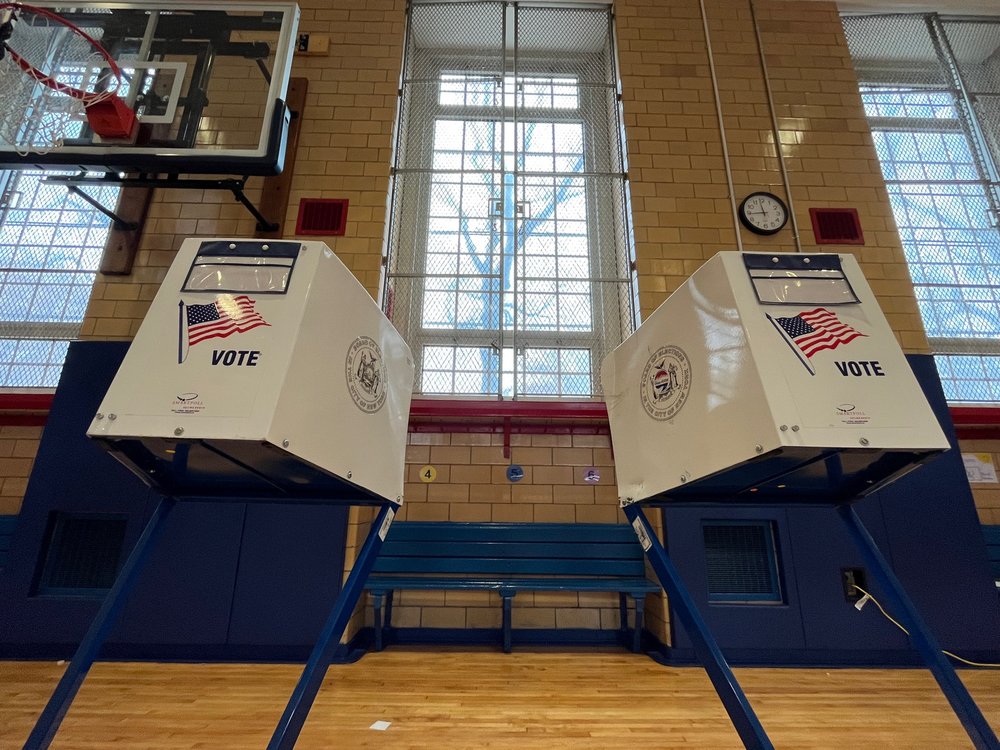
The Board of Elections released their latest count of votes in the races for mayor, comptroller, public advocate, City Council and others on Tuesday. Eagle file photo by Ryan Schwach
By Ryan Schwach
Three Queens candidates running for open seats in the City Council declared victory in their respective races on Tuesday after the city’s Board of Elections released its first ranked-choice voting tabulation in June’s primary election.
But while one of the three races appears to have a clear victor, the other two appear too close to call with hundreds of mail-in ballots yet to be counted by the BOE.
Tyrell Hankerson, who is running to replace his boss, Speaker Adrienne Adams, in District 28 in Southeast Queens, held a large lead in the five-person contest and appears to have easily secured the Democratic nomination for the seat.
The other two races for open seats aren’t as clear.
Local organizer Shanel Thomas-Henry declared victory in District 21, which covers parts of Corona, Elmhurst and Jackson Heights, after Tuesday’s count showed her leading the race by 373 votes over progressive candidate Erycka Montoya.
According to BOE data, there are still a little over 700 mail-in ballots left to count in the race – the next round of counting will take place next Tuesday.
Similarly, Phil Wong, a staffer for Conservative Councilmember Robert Holden hoping to succeed his boss, declared victory in District 30, which covers parts of Maspeth, Middle Village, Glendale, Ridgewood, Elmhurst, and Rego Park. Wong led the race on Tuesday by 235 votes with over 1,000 mail-in ballots left to be counted.
The RCV tallies released Tuesday also made Queens Assemblymember Zohran Mamdani’s historic and surprising victory over former Governor Andrew Cuomo in the mayor’s race official, as well Manhattan Borough President Mark Levine’s win in the Democratic primary for comptroller and Public Advocate Jumaane WIlliams’ win over Queens Assemblymember Jenifer Rajkumar.
Here’s more on the latest count.
District 21
Thomas-Henry maintained a 373 vote lead as of Tuesday afternoon over progressive candidate Erycka Montoya in the D21 race to replace term-limited Councilmember Francisco Moya.
District Leader Yanna Henriquez, who was backed by both Moya and the Queens County Democratic Party, finished in third in the race, ahead of fourth-place finisher David Aiken, who was endorsed by the area’s other local district leader, Hiram Monserrate.
Even with 700 outstanding mail-in ballots left to count, Thomas-Henry said her lead was solid enough to begin the celebration.
“I am overjoyed that our community has selected me to be their Democratic nominee for the next Councilmember in District 21,” she said in a statement to the Eagle. “Thank you to everyone who was a part of this journey and I look forward to working together with everyone. From Corona, to Lefrak City, to East Elmhurst, and Jackson Heights — we are one community, with one future.”
Montoya did not respond to requests for comment on Tuesday.
Henriquez thanked her supporters in a comment to the Eagle.
“While the outcome was not what we had hoped for, the experience has been profoundly humbling and inspiring,” she said. “This campaign was never just about one person — it was about all of us. About building a stronger, more compassionate, and more equitable community where every voice is heard and every neighbor is valued.”
In the ranked-choice voting count, Aiken’s votes distributed mainly to Thomas-Henry, who gained 411 votes after the first round. Following Henriquez’s exit, Montoya pulled in 544 votes to Thomas-Henry’s 290, but it was not enough to close the gap in the final round.
Results on election night showed Thomas-Henry performed strongly in the northern parts of the district near LaGuardia Airport, as well as the southern tip of the district adjacent to Queens Center Mall.
District 28
In District 28, Hankerson, Adams’ district chef of staff and chosen successor, is the apparent victor.
As of Tuesday afternoon, Hankerson – who raised the most money in the race – appeared to solidify his election day count, holding a near 2,000 vote and 18 percent lead over local activist Japneet Singh.
Singh, who pulled in overwhelming support from the district’s South Asian and Indo-Caribbean neighborhoods, was followed by Latoya LeGrand, former Councilmember Ruben Wills and Romeo Hitlall.
“This was a hard-fought race, and we are proud of the coalition we have built throughout this district,” said Hankerson. “From the very beginning, our message was one District 28, and we carried that message throughout the campaign. We are elated that the voters chose me, Ty Hankerson, to be their next representative, and we will fight every single day to make sure our district is affordable, is safe, and we all enjoy a better quality of life.”
Hankerson also thanked Adams, and other local backers.
“Thank you for the foundation you laid and the trust you put in me to make the Great 28 greater,” he said of his Adams, who he called his “boss and mentor.”
D28’s votes were almost directly split down either side of the Van Wyck Expressway with Hankerson pulling in the predominantly Black neighborhoods to the east, and Singh pulling in the voting districts to the west that are predominantly South Asian and Indo-Caribbean.
“I'm honored to have received over 40 percent of the vote in a district that has only 700 registered Sikh voters,” Singh said. “It is a testament to the coalitions and community we were able to build. This race also highlighted the systemic racism and discrimination that exists within our district and as we move forward there's a lot of work to be done to close those gaps.”
“I'm still going to be here, working every single day to close those gaps,” he added. “I would like to congratulate all the candidates that ran and look forward to working with each one of them to make a better District 28.”
In the ranked-choice voting count, Hitlall – the other candidate running from the district's western side – saw his votes go mainly to Singh, who received an additional 384 votes in round three when no other candidates got more than 90.
Wills’ exit in the fourth round saw votes distributed mainly to Hankerson, but Singh and LeGrand picked up some ground as well.
LeGrand’s exit handed over 1,000 votes to Hankerson, and only around 400 to Singh.
Hankerson had a near 10 point lead on election night, so Singh would have had to receive a significant share of RCV votes from remaining candidates to have a chance at catching up.
District 30
The race for Holden’s seat is currently the closest, and while Wong had declared victory it is still too close to call.
Wong, who was endorsed by his boss, led local civic leader and roller hockey league founder Paul Pogozelski by 235 votes, and the BOE had more than 1,000 outstanding ballots in the race as of Tuesday.
“I believe I can safely declare victory,” Wong said over the phone on Tuesday. “I feel encouraged by the unofficial ranked choice vote results. I still have to look forward to the certification from the Board of Elections that would put me officially in the victory spot. But right now, I believe I am the winner of the Democratic primary.”
Pogozelski, who pulled in overwhelming support in the district’s progressive areas in Ridgewood, didn’t concede on Tuesday.
“The numbers are in Phil’s favor at this moment,” he said. “It is still unofficial and we will congratulate him on the win once it is official.”
“Let’s see what the official results will be as there are some absentees and cures that need to be counted,” he added.
Pogozelski narrowed Wong’s election night win from four and a half points to three percent after the majority of Queens Democratic Party-backed candidate Dermot Smyth’s votes went to him in the final round. Pogozelski pulled in 1,129 votes from Smyth to Wong’s 886.
Smyth did not respond to requests for comment on Tuesday, but said last week that election day results didn’t look good for his campaign.
If Wong does ultimately pull out the race, he will face a fellow Bob Holden staffer, Republican Alicia Vaichunas, in the general election. The two have a close relationship, and Holden said he will not endorse between the two of them if they do face each other.
Citywide races
Tuesday’s ranked-choice count confirmed much of what was already known about Queens Assemblymember Zohran Mamdani’s victory in the Democratic primary for mayor on election night, which was called after Cuomo conceded far earlier than many expected.
Mamdani held on to his election night lead over Cuomo in the latest count, finishing with a more-than 100,000 vote lead, or 12 percent lead, over the former governor.
The 33-year-old socialist Queens legislator called his win a “mandate” following the highest mayoral election turnout since Mayor David Dinkins was elected in 1989.
"Last Tuesday, Democrats spoke in a clear voice, delivering a mandate for an affordable city, a politics of the future, and a leader unafraid to fight back against rising authoritarianism,” Mamdani said in a statement on Tuesday. “I am humbled by the support of more than 545,000 New Yorkers who voted for our campaign and am excited to expand this coalition even further as we defeat Eric Adams and win a city government that puts working people first."
Cuomo resigned around an hour and a half after the polls closed on election night, and the RCV totals confirmed his surprising loss to Mamdani.
“From the bottom of our hearts we thank the 428,530 New Yorkers who chose to rank Governor Cuomo as their choice for mayor and who believed in his vision to get the city back on track,” his spokesperson Rich Azzopardi said in a statement. “While it's 24,017 more votes than Eric Adams received four years ago, this primary saw a massive spike in voters under 30, and those who had never voted before – completely changing the overall electorate, which is why no poll or model predicted the outcome – an outcome which was also felt in council races citywide.”
Mamdani will face Mayor Eric Adams, former prosecutor Jim Walden, Republican nominee and Guardian Angels founder Curtis Sliwa, and Cuomo in the November general election, but Cuomo has not confirmed if he will actively campaign in the race.
In the race for comptroller, incumbent Jumaane Williams’ lead over Queens Assemblymember Jenifer Rajkumar and businessman Marty Dolan remained relatively unchanged from election night to Tuesday’s count.
Williams pulled in around 71 percent of the vote to Rajkumar’s 18 percent and Dolan’s 9 percent.
Mark Levine’s election day lead in the race for comptroller was further solidified after the ranked-choice voting count on Tuesday. He pulled away with 58 percent of the vote in the final round of counting over Justin Brannan, who brought in 41 percent.
Brooklyn org takes charge at embattled Queens legal services provider
Jul. 2nd, 2025 07:29 pm
Brooklyn Defender Services assumed control over Queens Defenders’ criminal defense practice on Tuesday. Eagle file photo by Walter Karling
By Jacob Kaye
Queens Defenders officially had its criminal defense practice taken over by a Brooklyn-based legal services provider on Tuesday, around three weeks after its former executive director was arrested on federal fraud charges.
Brooklyn Defender Services officially assumed the responsibility of carrying out a city contract to provide criminal defense for indigent clients previously held by Queens Defenders this week, hiring all of the Queens organization’s criminal defense attorneys and support staff.
The transition of the approximately 16,000 new cases per year has been underway since late March, when the city suggested it no longer trusted the embattled Queens organization to carry out the promise of the $32 million contract to provide criminal defense to low-income New Yorkers in the World’s Borough. Though Queens Defenders’ former executive director, Lori Zeno, had yet to be charged with fraud at the time, she had been booted from the organization by Queens Defenders’ board of directors after they received a number of complaints about her conduct.
With the transition now complete, Brooklyn Defender Services will operate out of Queens Defenders’ existing office space on Queens Boulevard in Forest Hills and out of its office in Jamaica.
All of the attorneys previously working in the criminal and adolescent practices at Queens Defenders have been hired by Brooklyn Defenders, according to the Brooklyn organization.
“After 29 years of experience and expertise serving Brooklyn, we are proud to bring the same dedication and excellence to Queens residents,” Lisa Schreibersdorf, the executive director and founder of Brooklyn Defender Services, said in a statement. “We will continue in our mission to provide outstanding representation and advocacy free of cost to people facing loss of freedom, family separation, and other serious legal harms.”
“Despite many challenges over the past year, the staff in Queens have remained deeply committed to their clients and their work,” she added. “We are proud to welcome this team of hardworking, skilled, and mission-driven attorneys and support staff.”
Queens Defenders’ troubles began to emerge in January, when Zeno was put on leave by the organization’s board of directors.
Though they didn’t specify the reasons behind her then-temporary dismissal, the organization’s board chair directed staff with complaints to reach out to the New York attorney general’s whistleblower office, which fields information from insiders “with sensitive information about misdeeds by their employer.” Zeno was also barred from entering into any of Queens Defenders’ offices.
“As a result of information received by the Board of Queens Defenders, Lori Zeno has been placed on leave effective immediately and is not allowed on any Queens Defenders property,” Doneath Powell, the board chair, said in the email obtained by the Eagle in January.
By March, the city had decided to sever the contract to provide criminal defense it had with Queens Defenders, and began moving the work over to Brooklyn Defender Services.
Though the city did not say whether or not the move was related to Zeno’s dismissal, a spokesperson for MOCJ said the agency was “taking a proactive approach with the Queens Defenders in order to ensure stability and minimize disruptions to the attorneys and cases involved.”
“Separately, we have initiated a financial and operational review after identifying red flags during our routine oversight, and we will take any action appropriate upon conclusion of the investigation,” the spokesperson said at the time.
On Tuesday, a spokesperson for MOCJ said that the city was “grateful for Brooklyn Defenders' management and for the cooperation of the defense attorneys in Queens who have successfully transitioned to new leadership, ensuring there was no disruption in services and that their clients will continue to receive excellent representation.”
The severed contract more than likely was related to the fraud charges brought against Zeno in June.
Federal prosecutors allege that Zeno and her husband, Rashad Ruhani, stole tens of thousands of dollars from the organization, which is primarily funded by taxpayer dollars.
According to the charges, Zeno and her husband used a credit card issued to the organization to fund a luxury vacation to Bali, a teeth-whitening procedure, a night at a high-end steakhouse and other personal purchases.
Prosecutors also say the pair lied to their co-workers, asking for reimbursements on personal expenses, like rent on their $6,000-a-month penthouse apartment while claiming the charges were business expenses.
The couple allegedly attempted to cover up the fraud by hiring two people close to them to work as Zeno’s executive assistants and submit fake expense reports, prosecutors said. The workers were officially brought on to serve in non-existent positions with little to no responsibilities, a court document alleges. One of the employees brought on to help with the cover up, Ureka Washington, was Ruhani’s legal wife – prosecutors claim Zeno and Ruhani were married in a religious ceremony not recognized by the state.
Zeno pleaded not guilty to the fraud charges last month and will next appear in court in September.
In March, Zeno, who was believed at the time to be under federal investigation, told the Eagle that she had “every bit of proof that I need, about every single allegation that was made” ahead of her ouster from Queens Defenders.
Zeno, who helped found the organization around 30 years ago, was paid $434,791 in 2023, the highest salary among all executive directors of major public defender groups in the city.
City funds crucial step in bringing trauma center to Rockaway
Jul. 2nd, 2025 07:25 pm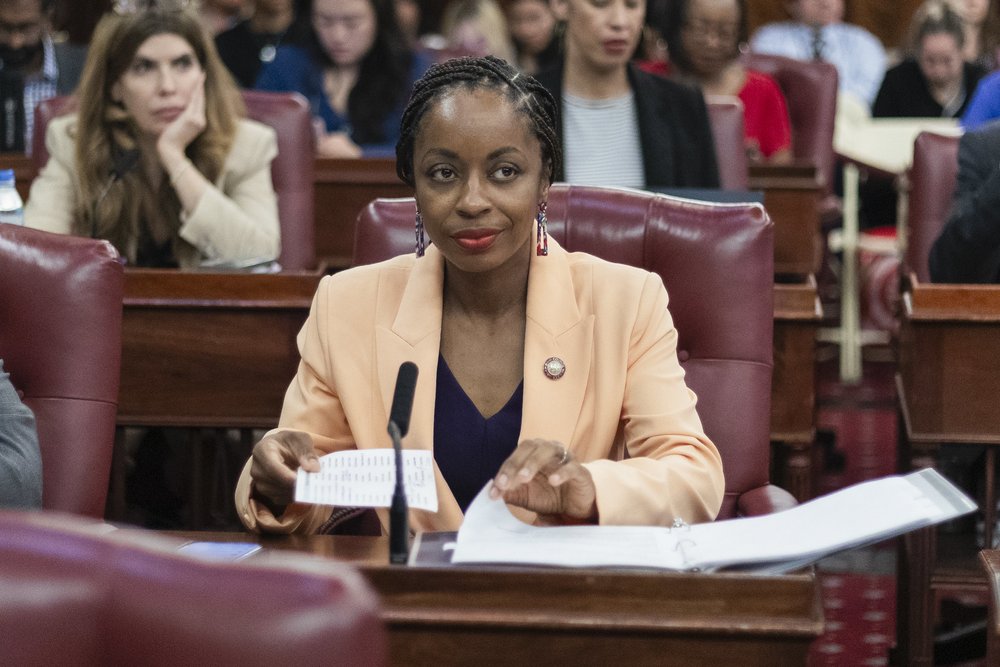
Money for a $300,000 land transfer pivotal to getting a trauma center in the Rockaways was funded through the city budget this week, Councilmember Selvena Brooks-Powers announced. Emil Cohen/NYC Council Media Unit
By Ryan Schwach
The money needed to fund a key step in the fight to build a trauma hospital in the Rockaways was included in the city’s budget this week.
Following calls from locals and politicians to include the $300,000 to facilitate a land transfer for a potential trauma center site, the Adams administration and City Council stayed true to their commitment and included the funds in the city’s budget passed on Monday.
The funding will go toward transferring the potential future site of a much-desired Rockaway trauma center on Beach 62nd Street from its current owner, NYCHA, to the city.
“For too long, Far Rockaway has lacked access to trauma care,” said City Councilmember Selvena Brooks-Powers, who has spearheaded the local push for a trauma center. “This $300,000 commitment clears a key hurdle in building the trauma center our community so desperately needs. I thank Mayor Adams for his leadership in committing this funding, and I remain grateful to our partners in labor, healthcare, and local government for standing with us to deliver on this site for the trauma center. This is not just an investment in infrastructure — it’s an investment in lives.”
Brooks-Powers, her elected colleagues and several locals rallied on Friday calling for the money to be included in the budget after the Adams administration reportedly promised it would be several months ago, according to Brooks-Powers.
“Our administration has always said that the Rockaways should not be left behind, and under our administration, they never will be,” Adams said in a statement. “We are proud to work in lock-step with Councilmember Brooks-Powers to ensure that the Rockaways has access to the health care it deserves as we take this step to ensure we are keeping New Yorkers safe and healthy, and as we make New York City the best place to raise a family.”
In a report last year, a task force dedicated to studying the possibility of bringing a trauma center to the Rockaways identified the site in question, located on Beach 62nd Street, as a possible site.
The report pointed out the area would not require any demolition, is near a subway station and is not adjacent to nearby residences.
Currently, the closest level one trauma center for most Rockaway residents is around 10 miles away at Jamaica Hospital, which takes more than half an hour to get to, often made more difficult by ever-present traffic on the Van Wyck Expressway.
“The nearest emergency trauma facility is approximately 10 miles away, and response times continue to place people's lives at risk,” said Community Board 14 District Manager Felicia Johnson. “This proposed trauma center would be the first step in writing decades of disinvestment and neglect, ensuring that all New Yorkers, regardless of their zip code, can access life saving medical treatment when it matters most.”
Zulip Server 10.4 security release
Jul. 2nd, 2025 05:05 pmimportant security issue (CVE-2025-52559), as well as several bugs.
Upgrading
We recommend that all installations upgrade to this new release. See the
upgrade instructions
in the Zulip documentation. Zulip Cloud has already been …
Housing Code Violations in NYCHA Units Will Finally Be Made Public
Jul. 2nd, 2025 06:52 pm
The city agency that polices housing code violations has for years publicly posted inspection results for all privately-owned housing — but not inspection results in public housing apartments.
That’s kept NYCHA tenants in the dark about sometimes dangerous living conditions and the Housing Authority’s failures to remedy them.
That’s about to change. Under a settlement reached last month, the Department of Housing & Preservation Development (HPD) has agreed to begin posting details of all inspections performed in New York City Housing Authority (NYCHA) developments on its portal HPD Online.
They were supposed to begin doing that a long time ago after the city’s administrative code was changed in January 2023 requiring HPD to post publicly the results of all its inspections of NYCHA units. Eight months later THE CITY reported on how those inspections were still not public.
The New York Legal Assistance Group wrote to then-HPD Commissioner Adolfo Carrion, pressing him to follow the law, and in October the group filed a lawsuit against HPD in Manhattan Supreme Court.
Two weeks ago NYLAG and HPD reached a settlement in which HPD agreed to begin posting all inspection results in NYCHA buildings starting Sept. 15. In exchange, NYLAG agreed to drop the suit.
HPD made no admissions of wrongdoing, but did agree to pay NYLAG $10,000 for legal fees.
“HPD has been actively working to implement the state law requiring the agency to provide information about HPD violations issued to NYCHA as a result of Housing Court-requested inspections. HPDOnline is a key resource for property owners and tenants, and we’re proud to make even more information accessible to New Yorkers each year,” said Natasha Kersey, Deputy Press Secretary at HPD.
“The settlement marks a significant milestone in the fight for housing justice for NYCHA tenants and underscores the importance of equal access to information for all tenants, regardless of who owns their building,” said Danielle Tarantolo, Director of NYLAG’s Special Litigation Unit. “This agreement affirms that NYCHA tenants deserve the same transparency and accountability as every other New Yorker.”
NYCHA is currently overseen by an independent monitor picked by the U.S. Department of Housing & Urban Development (HUD) and the Manhattan U.S. attorney as a result of an agreement in which NYCHA promised to abate lead paint, clean up toxic mold, fix busted elevators and heat systems and address chronic pest problems by set deadlines.
The authority owns 175,000 aging apartments across the city that have been plagued for years by deteriorating conditions. Recently NYCHA began shifting management of thousands of these units to private developers under a program known as Rental Assistance Demonstration (RAD). To date 37,000 are in the program, with another 25,000 scheduled to be transitioned in the coming years.
The HPD settlement will apply to all the RAD buildings as well.
Our nonprofit newsroom relies on donations from readers to sustain our local reporting and keep it free for all New Yorkers. Donate to THE CITY today.
The post Housing Code Violations in NYCHA Units Will Finally Be Made Public appeared first on THE CITY - NYC News.
Trump’s Homeland Security Council Sets Its Sights on Zohran Mamdani
Jul. 2nd, 2025 06:14 pm
President Donald Trump’s Homeland Security Advisory Council — a group that includes Rudy Giuliani, cop-turned-actor Bo Dietl and the founder of Bikers for Trump — held its first meeting on Wednesday to discuss the top threats facing the nation.
The conversation quickly turned to New York City mayoral candidate Assemblymember Zohran Mamdani.
After hearing Giuliani deliver a speech against asylum-seeking immigrants, Department of Homeland Security Secretary Kristi Noem chimed in.
“I want to ask you: Do you want to run for mayor of New York again?” she asked, drawing cheers and applause from around the conference room.
“Bo and I have been talking about putting together some kind of strategy. It’s doable if it’s one candidate. It’s a suicide mission if you’re three,” Giuliani said.
The longtime GOP politician called the Republican in the race, Curtis Sliwa, “our candidate.” He labeled Eric Adams — the current mayor running for reelection as an independent whose criminal indictment was dropped by the Justice Department to free him up to support Trump’s anti-immigration policies — as “kind of our candidate.” And he reserved the worst insult for former governor Andrew Cuomo, who lost to Mamdani in the Democratic primary but could still mount an independent campaign.
“I’ve known him since he was 15 years old. His mother would describe him as, ‘Well, Chris is the smarter boy,’” Giuliani joked, referring to the former governor’s journalist brother.
But all that was a prelude to a parley over Mamdani, the 33-year-old Democratic Socialist who’s running on a platform that champions the working class with rent caps for rent-stabilized units, police accountability and what he calls “Trump-proofing NYC.”
“This is not an exaggerated problem,” Giuliani told the 22-person council. “Somehow we got the combination of an Islamic extremist and a communist.”
Mamdani is Muslim, but Giuliani’s remark is an attempt to label as a threat a Democratic politician who has repeatedly said he does not question Israel’s right to exist as a nation but has called Israel’s retaliatory attacks on Gaza since Oct. 7, 2023, a “genocide.”
The Homeland Security Advisory Council is not typically so heavy on politics. It was created in 2003 in the wake of the Sept. 11 attacks and, as stated in the Federal Register, is meant to provide “nonpartisan and organizationally independent strategic advice to the Secretary of Homeland Security on critical matters related to Homeland Security.” Its current charter, issued in March, says that it will spend about $800,000 a year and dish out advice on “terrorist attacks, major disasters, or other emergencies” from “national leaders” in academia, business, and experienced first responders.
The meeting’s rancor aimed at Mamdani continued when Noem called on David Chesnoff, a prominent Las Vegas attorney who previously defended Corey Lewandowski — yet another Trump adviser on the council — from accusations of making unwanted sexual advances on a Republican donor at a 2021 event.
“I want to do this because I’m tired of the normalization of anti-American philosophy, for example, in New York … it’s amazing you can have the Hezbollah flag being marched within shouting distance of where the towers fell,” he said, referencing the Sept. 11, 2001, attacks.
“We have somebody running for mayor … that applauds the very same philosophy and people that did that,” Chesnoff continued. “We need to send a bigger message to the American public of the danger that poses.”
That comment appeared to catch Noem’s attention. Noem, whose department oversees the increasingly militarized deportation raids frequently led by masked people who hide their names and badges, said she’s looking for creative ways to expand her power.
“The Department of Homeland Security has authorities that have never been utilized before … and I’m going to need some good minds on how to use those authorities,” she said.
Her comment comes just one day after Trump, speaking from a new mass immigration incarceration camp quickly built in the South Florida swamp, threatened to jail Mamdani if he attempts to stop Immigration and Customs Enforcement in the city and disparaged him as a “communist.”
Following a rally where he received the endorsement of some of the city’s top unions, Mamdani responded to Trump’s comments and those from officials on the council Wednesday branding him a security threat, calling the comments a distraction “from what I fight for.”
“And ultimately, what I fear,” he said, “is that if this is what Donald Trump and his administration feel comfortable about saying about the Democratic nominee for the mayor of New York City, imagine what they feel comfortable saying and doing about immigrants whose names they don’t even know.”
Jose Pagliery is a reporter for NOTUS.
This story was produced as part of a partnership between NOTUS and THE CITY.
Our nonprofit newsroom relies on donations from readers to sustain our local reporting and keep it free for all New Yorkers. Donate to THE CITY today.
The post Trump’s Homeland Security Council Sets Its Sights on Zohran Mamdani appeared first on THE CITY - NYC News.
Hot Topic to debut expanded store at Queens Center mall
Jul. 2nd, 2025 06:53 pmJul. 2, 2025 By QNS News Team
Hot Topic is making a loud comeback at Queens Center.
The alternative pop-culture retailer is celebrating the re-grand opening of its newly expanded and relocated store inside the Elmhurst mall with a weekend-long series of in-store activations, giveaways and live entertainment from Friday, July 11 through Sunday, July 13.
To mark the occasion, the store will feature live DJs spinning from 3 to 5 p.m. each day. The first 100 guests in line daily will receive a $25 Hot Topic gift card, and additional surprise giveaways are planned throughout the weekend.
The new store, now occupying a larger footprint than its previous location, offers a broader selection of music, anime, gaming, and cult-classic fandom merchandise—including apparel, collectibles, and exclusive licensed items. Its relocation and expansion are part of Hot Topic’s broader strategy to revitalize its retail presence by enhancing the in-store experience and building community engagement.
Hot Topic first opened in Southern California in 1989, and rose to prominence in the 1990s and early 2000s for catering to teen and young adult audiences interested in alternative music, goth fashion and pop culture fandoms.
Queens Center has been home to a Hot Topic location for over two decades. The mall, situated at the intersection of Queens Boulevard and 59th Avenue in Elmhurst, is open Monday through Saturday from 10 a.m. to 9 p.m., and Sundays from 11 a.m. to 8 p.m. For more information, visit shopqueenscenter.com or check out Hot Topic’s event updates on social media.
The post Hot Topic to debut expanded store at Queens Center mall appeared first on Jackson Heights Post.

